Missouri, with its diverse landscapes and climates, is a haven for a wide array of insects. While many of these creatures play crucial roles in the ecosystem, there are a few that serve more as an annoyance than they are beneficial. Their growing populations, coupled with their biting tendencies, can make outdoor activities less enjoyable and even potentially hazardous.
In this article, we will highlight the most annoying insects you may encounter in Missouri. We aim to provide you with valuable insights into these creatures, as well as their biting habits, making your experience outdoors in Missouri safer and more enjoyable.
1. Mosquitoes (Culicidae)
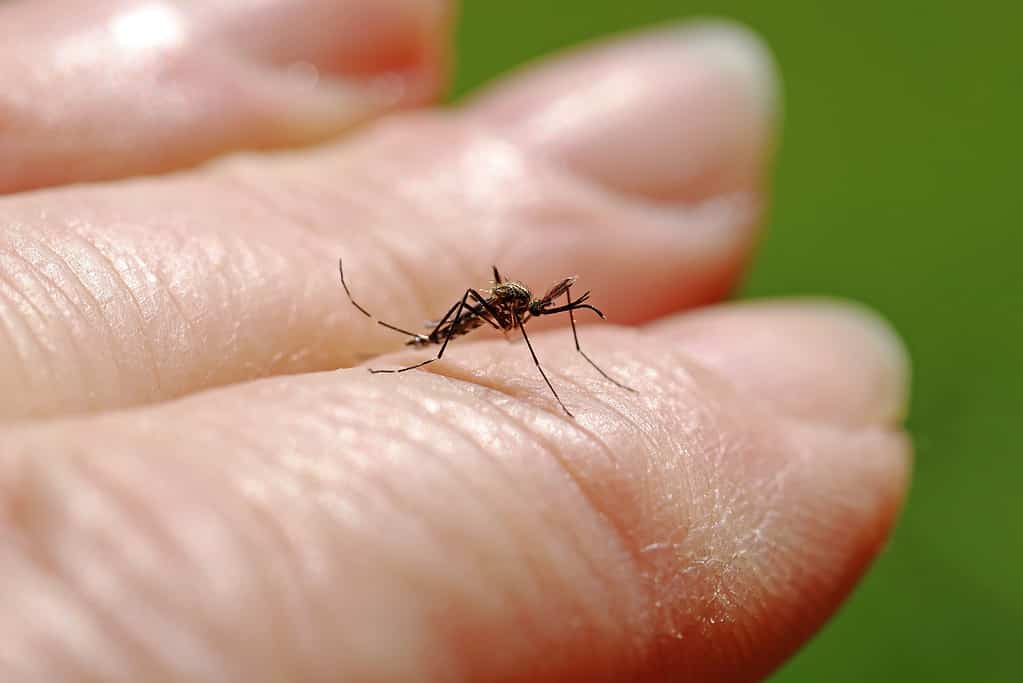
Mosquitoes are easily the most common annoying insect in Missouri due to their love for human blood.
©Astrid860/ via Getty Images
Missouri is home to about 50 different kinds of mosquitoes, many of which are adapted to the state’s hot summers and chilly winters. However, these species are not evenly distributed across the state.
These tiny bloodsuckers, characterized by their slender bodies, long legs, and a single pair of wings, generally measure between 0.15 and 0.4 inches in length. A few species can be even smaller than 0.1 inches.
Both male and female mosquitoes possess antennas and a long, pointed beak-like mouthpart, referred to as a proboscis, which is three to four times the length of their head.
Mosquito habitats vary significantly. Some species love human dwellings, while others favor forests, marshes, and tall grasses. Regardless of their preference, all mosquitoes are attracted to water bodies, still or slow-moving, as they serve as the breeding grounds for their larvae and pupae. Different water environments can attract diverse mosquito types.
Interestingly, it’s only the female mosquitoes that feed on blood. The males, on the other hand, sustain themselves on plant nectar and juices.
Why Are Mosquitoes Annoying?
It is pretty easy to see why these insects can be a HUGE disturbance. Amongst pests, mosquitoes easily claim the title of being the most annoying. Their uncanny ability to disrupt outdoor gatherings is notorious, and the familiar buzzing in your bedroom at night can be a real nuisance. Adding to the irritation, when a mosquito bites, it deposits its saliva into your skin, causing your body to react with the familiar itch and bump.
The impact of mosquitoes on human health is staggering. No other creature inflicts more harm on humans. Each year, mosquito-borne diseases are responsible for over a million deaths worldwide!
2. Deer Flies (Chrysops)
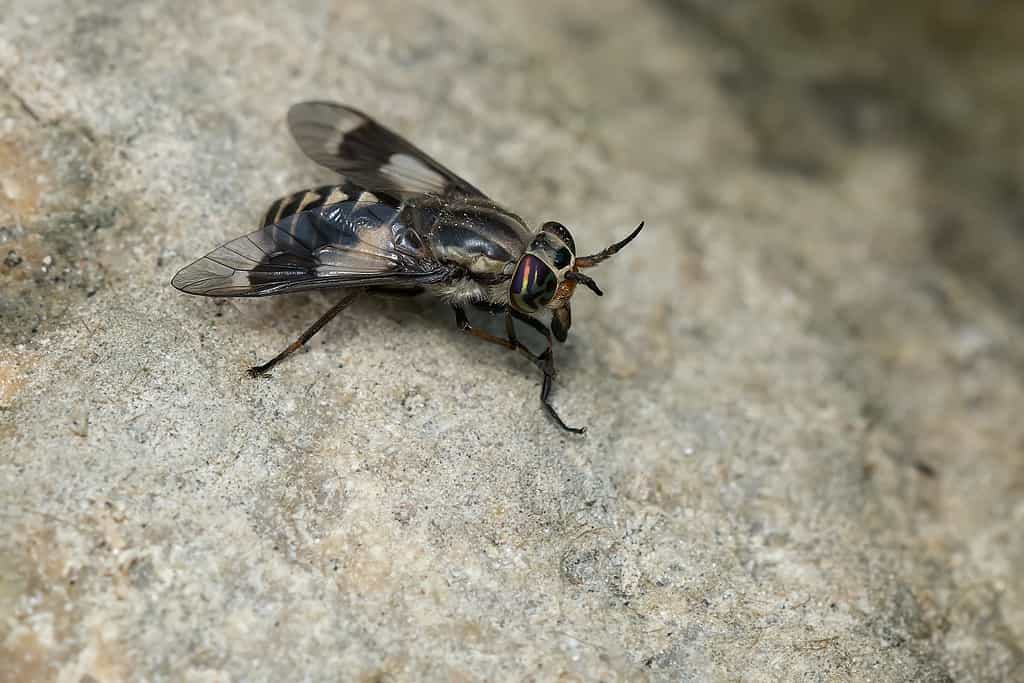
Equipped with razor-sharp mouthparts, female deer flies inflict a painful bite on unsuspecting victims.
©Paul Reeves Photography/Shutterstock.com
Deer flies are an all too familiar insect species across the US, including Missouri.
Regarding their size, adult deer flies typically measure between ¼ to 1/3 inches in length. One striking feature of these insects is their wings, which are transparent with dark bands or patches. Their bodies display a gray or light brown hue, with some varieties showcasing black and yellow stripes. Their large, vibrantly colored eyes are a distinctive trait of deer flies.
The antennae of these pesky creatures tend to be lengthier than their heads.
These insects thrive in moist environments such as wetlands, woods, ponds, marshes, and streams. They are most active during June and July within their geographic range.
Interestingly, the feeding habits of deer flies differ between the sexes. While females incessantly seek out animal blood as their main food source, males primarily feed on plant nectar and pollen. Their larvae, which are aquatic, feed primarily on organic waste material.
Why Are Deer Flies Annoying?
Deer flies can inflict quite painful bites using their sharp mouthparts. Though these bites usually don’t have long-term effects, some people may experience allergic reactions. Further, these flies can be carriers of diseases like tularemia and may transmit them to humans through their bite.
Unlike many other biting insects, deer flies have a preference for the head and neck area. Remarkably, the females are incredibly stubborn in their pursuit of a blood meal, often returning to the same person repeatedly until successful. Trying to swat them away often only seems to increase their determination for a tasty meal.
3. European Hornet (Vespa crabro)

While they are not as aggressive as other hornet species, the European hornet can inflict a painful sting and bite when they are threatened.
©Ger Bosma Photos/Shutterstock.com
The European hornet is one of the most widespread insect hornet species in Missouri.
These are pretty large insects, with adults typically measuring between 1 and 1.3 inches long. Sporting brown bodies adorned with yellow abdominal stripes and a light-colored face, they have two pairs of wings and six legs.
These hornets typically establish their nests in hollow trees, making forests and their borders their prime habitats. However, they aren’t limited to these areas and can be found in parks or suburban regions with ample trees or other viable nesting places. There have also been instances of them building nests underground.
In terms of diet, European hornets feed on a range of large insects, including flies, yellowjackets, grasshoppers, and honeybees. They also supplement their diet with fruits, tree sap, and honeydew.
Why Are European Hornets Annoying?
These hornets are known to inflict significant damage to trees and shrubs, peeling the bark to access the sap underneath and using the bark fibers to construct their nests.
Many hornet species are known to be incredibly aggressive, stinging people even when unprovoked. Though European hornets are capable of stinging, they aren’t an overly aggressive hornet species and are more likely to retaliate only when they feel threatened. Despite their large size, their sting is comparable in pain to that of a regular honey bee. The annoyance factor, however, escalates as, unlike honey bees, these hornets can sting multiple times!
4. No-See-Ums (Ceratopogonidae)

This is a Scottish midge, a species of no-see-um is a teeny tiny biting bug.
©Jamierpc/Shutterstock.com
No-see-ums, with more than 1,000 species globally, have made their presence known throughout the world, including Missouri. North America alone hosts 676 species spread across 39 different genera.
Adult no-see-ums are tiny, almost invisible, gray insects measuring less than 1/16 inch long. Their wings, covered in a thick layer of hair, exhibit intricate color patterns. When examined closely or through a microscope, they resemble miniature versions of mosquitoes.
The breeding habitats of no-see-ums vary from one species to another. These pesky creatures choose to multiply in a range of environments, including muddy plains, freshwater zones, coastal salt marshes, and moist tree hollows. These breeding sites are typically located in heavily shaded regions on the fringes of grassy marshes.
While both sexes feed on plant nectar, it’s only the female no-see-ums that bite and consume blood, similar to their mosquito counterparts.
Why Are No-See-Ums Annoying?
Don’t let their small size fool you. These tiny bugs can deliver substantial pain with their bites. Females, in particular, are the biters, and they favor warm climates, congregating near coastal areas abundant in water and marshlands. Whether you call them biting gnats or biting midges, the consensus is universal — they’re annoying!
The bites from these insects can be irritating and painful, sometimes causing prolonged discomfort for certain individuals. Often, victims of their bites feel the pain but cannot see the insect due to its tiny size.
5. Fleas (Siphonaptera)
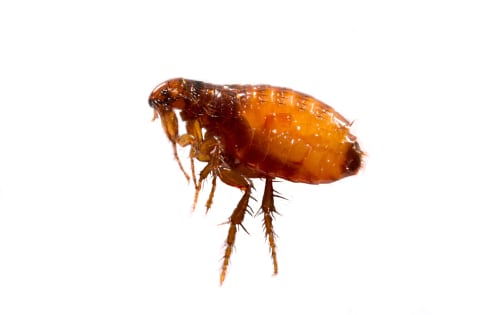
Tending to only affect mammals with lots of fur, fleas can leave painful bites that will get inflamed and infected when scratched.
©Vera Larina/Shutterstock.com
Fleas, infamous for their blood-sucking habits, are found across the globe. Of the more than 2,200 species identified worldwide, around 30 species of this insect make their home in Missouri. Interestingly, only a handful of these species interact with humans.
These pesky insects have dark red to brownish-black hues. They sport a rigid exoskeleton covered in hairs that point backward, enabling them to navigate effortlessly beneath a host’s fur or hair and cling onto the host persistently. An adult flea’s size typically ranges from 0.039 to 0.13 inches in length.
As far as feeding habitats go, fleas can thrive on any warm-blooded creature, but they show a preference for humans, dogs, rats, cats, opossums, and other rodents. These tiny hitchhikers can also latch onto shoes, pant legs, or blankets. And when winter rolls around, they’re more than happy to find shelter inside homes!
A flea’s diet isn’t limited to just blood from humans and pets. They also feed on feces and decaying organic matter. Yet, they are most notorious for their blood-sucking behavior. Given their diverse diet, one might classify fleas as omnivores.
Why Are Fleas Annoying?
These minuscule creatures can be quite a nuisance and can prove challenging to eliminate. Often brought into homes by pets, they latch onto fur and turn your beloved pet into a full-service buffet and nursery. They feed, breed, and live off their hosts, making them a pesky problem.
The telltale signs of flea bites are hard to ignore. They cause intense itching, and the skin surrounding the bite may become painful or tender. It’s not uncommon to see hives or a rash develop around the bite area. Persistent scratching can lead to further skin damage and even result in a bacterial infection at the bite site.
6. Bed Bugs (Cimex lectularius)
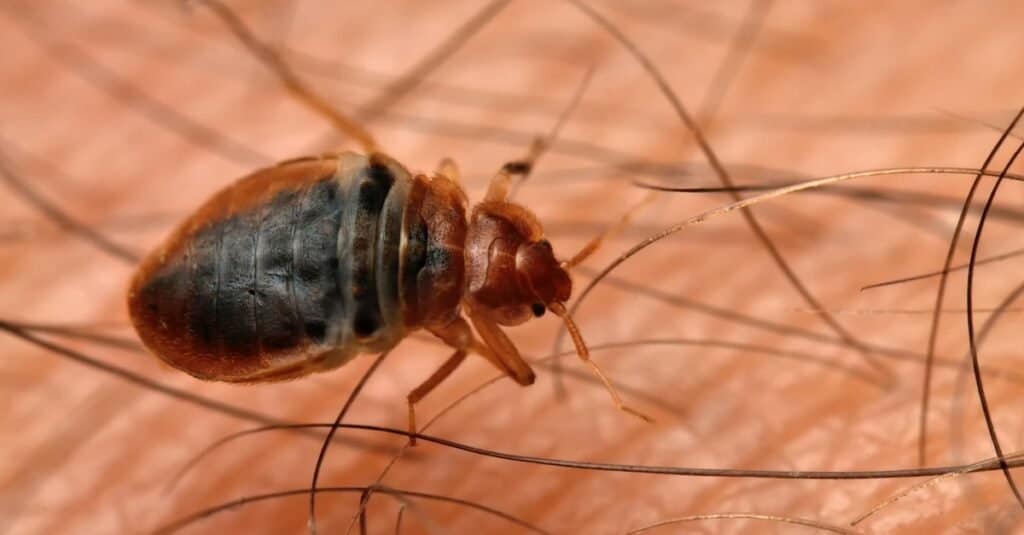
Hiding in mattresses, clothing, blankets, and other furniture, bed bugs can be an extremely annoying nuisance that will leave painful bites on humans.
©D. Kucharski K. Kucharska/Shutterstock.com
Bed bugs have carved out quite a reputation as a common annoying insect in Missouri, often catching people off guard with their bites.
These critters are flat-bodied and sport a reddish-brown color. Their size doesn’t exceed that of an apple seed, making them difficult to spot. The eggs of bed bugs are tinier still, bearing a color spectrum that ranges from white to pale yellow.
Unlike other insects on our list, bed bugs actually share our living spaces. They’re found in various dark nooks and crannies, particularly near sleeping areas. You might find them lurking under mattresses, beneath floorboards, inside carpets, in wall cracks and crevices, within bed frames, and even behind peeling wallpaper.
Interestingly, bed bugs maintain a strict diet of blood, undeterred by lack of access to it. They don’t resort to cannibalism in challenging times, nor can they digest food scraps or dead skin cells.
Why Are Bed Bugs Annoying?
While they don’t spread diseases, bed bugs can still be annoying. Their presence may cause itching and disrupt your sleep. As they feed on warm-blooded beings, they find you, specifically your body heat, exhaled carbon dioxide, and other biological factors, irresistible.
Symptoms of their bites typically involve itching, inflamed skin that may look like a pimple or rash, and a burning sensation.
7. Fire Ants (Solenopsis)
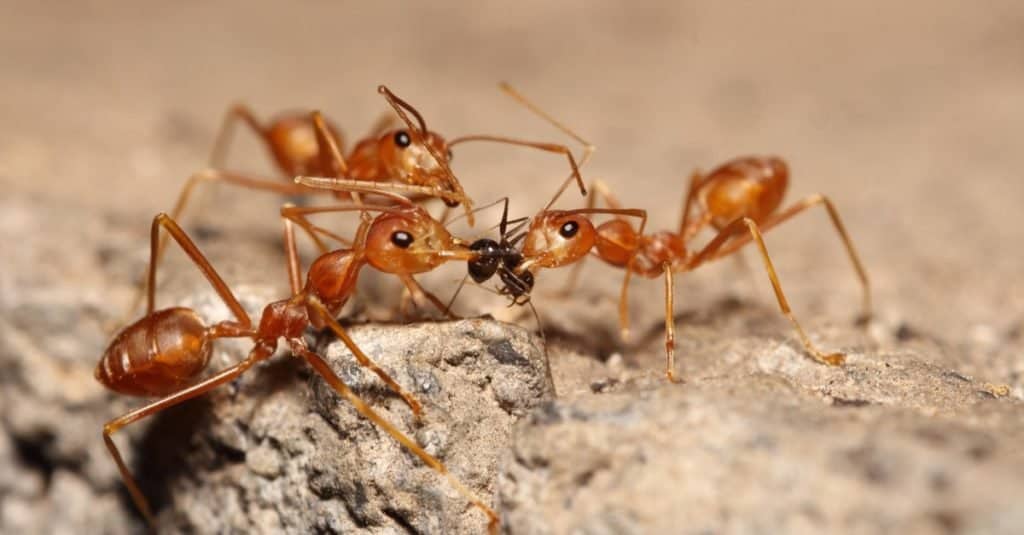
These red ants hail from the tropics and have become invasive in many parts of the USA, including Missouri. They are extremely aggressive and have a painful sting.
©sarawuth wannasathit/Shutterstock.com
Fire ants, originating from tropical climates, are insects that are unable to endure the frigid Missouri winters but are rather lively in other seasons.
Distinguishable by their dull reddish-brown to dark red color, fire ants also possess a stinger. The worker ants of this species come in varying sizes, from 1/16 inch to 1/4 inch.
These ants typically establish their homes in mounds composed of mud and decaying leaves, often favoring sunny, damp locations such as parks, lawns, fields, and meadows. They are capable of colonizing almost any type of soil and have been found nesting in rotting stumps and logs, as well as around tree bases.
Omnivorous in nature, fire ants consume plant matter, insects, and other small creatures.
Why Are Fire Ants Annoying?
Though fire ants do not bite, they do inflict extremely painful stings. Fire ants can be more than a mere annoyance due to their aggressive nature. They tend to attack and sting repeatedly when they feel their territory is being encroached upon.
The initial sting from a fire ant not only causes immediate sharp pain but is also followed by an agonizing burning sensation due to the venom injected (hence the name “fire” ant). Itching red bumps quickly emerge around the inflamed area, further affirming why these ants are named fire ants.
8. Yellowjackets (Vespidae)
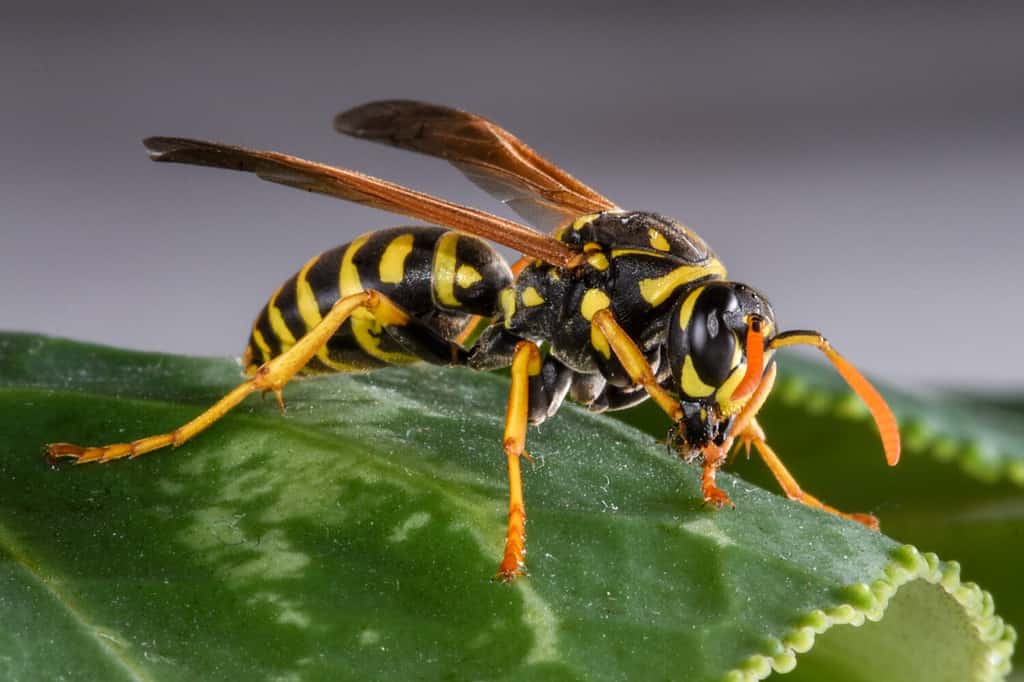
Feeding on a carnivorous diet, yellow jackets primarily prey on other insects like flies and bees. These insects are also territorial and will often sting unprovoked.
©Randy Runtsch/Shutterstock.com
Missouri is home to two species of yellowjackets: the eastern and the southern variants. Additionally, the German yellowjacket is an invasive species commonly found in the vicinity of St. Louis.
Resembling bees, yellowjackets are primarily flying insects, distinctively marked by their slender ‘waist,’ making their body segmentation more apparent. They mostly sport yellow and black hues, although some species may carry white or red patterns.
Yellowjackets tend to live alongside humans. They often establish their nests in subterranean areas, tree stumps, hollow logs, in-between walls, attics, beneath eaves, and even inside recycling bins known for containing sugary residues.
The diet of adult yellowjackets comprises food sources rich in carbohydrates and sugars, like plant nectar and fruits. Moreover, they are keen on high-protein foods, such as other insects.
Why Are Yellowjackets Annoying?
Yellowjackets not only pose a threat to humans due to their aggressive nature but are also infamous for attacking large honeybee colonies for sustenance, consuming both the bees and their larvae. As if their mere presence wasn’t irritating enough, their stings, which they can deliver multiple times, are notably painful.
9. Stable Flies (Stomoxys calcitrans)

This harmless-looking fly species has a painful bite and will feed on your blood.
©Vinicius R. Souza/Shutterstock.com
Stable flies are a common type of insect found throughout the state of Missouri.
Their light grey bodies, broad abdomens adorned with a “checkerboard” pattern of several dark spots, and notably long, protruding, piercing mouthparts at the front of their heads distinguish these flies.
Hay ring feeding sites serve as the ideal habitat for stable flies, with the leftover hay in fields proving a fertile breeding ground.
These annoying insects feed on blood. While large hoofed mammals like cattle and horses are the primary food sources for stable flies in the U.S., these insects are also known to feed on a variety of other creatures, including goats, pigs, sheep, cats, donkeys, dogs, and even humans.
Why Are Stable Flies Annoying?
The annoyance and irritation caused by stable flies are significant. Being adept fliers that feed during the daytime, their bites result in itchy, painful spots and lumps, often with a central crust. The most commonly targeted areas for their painful bites include the neck, groin, chest, back, and legs.
10. Head Lice (Pediculus humanus capitis)
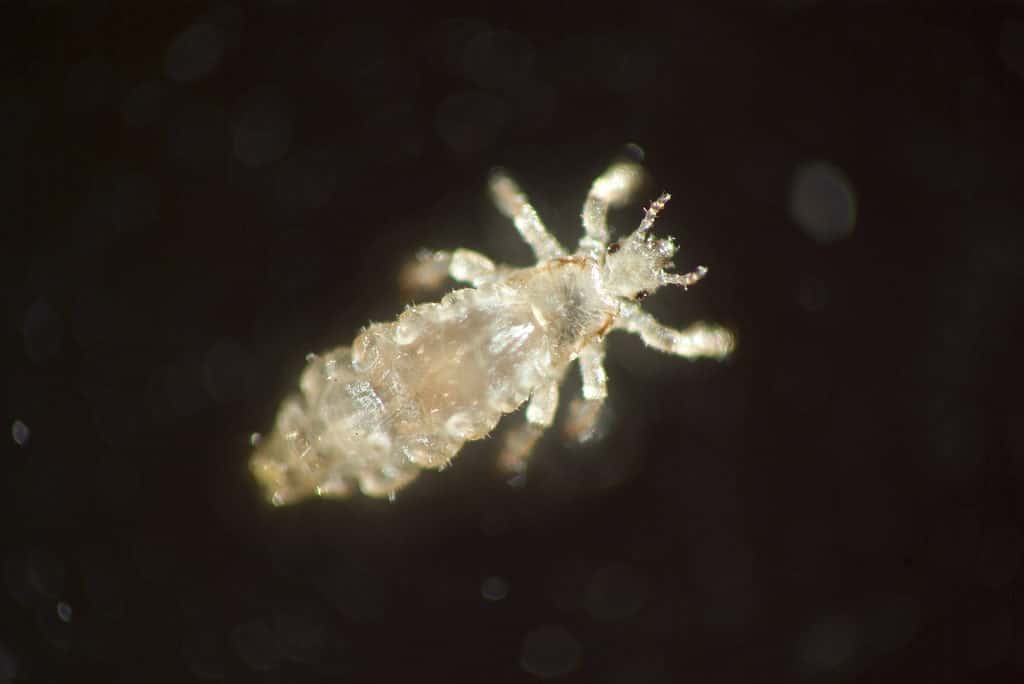
The scientific name of head lice is
Pediculus humanus capitis. This is a TINY and especially annoying insect that inhabits the scalps of humans under the hair, hence the name “head lice.”
©iStock.com/toolipz
Even though there isn’t exact data on the number of head lice cases in the United States annually, it’s estimated that between 6 million to 12 million infestations occur every year among children aged 3 to 11, and Missouri is not exempt from this statistic!
An adult louse, which is fully grown, is roughly the size of a sesame seed, with six legs and a tan to grayish-white hue. The color of the lice might seem darker on individuals with dark hair compared to those with lighter hair.
The human body and clothes are the exclusive living environments for these lice. Head lice mainly reside on head hair but have been known to venture onto other body parts.
Head lice don’t feed on the scalp or hair. They depend entirely on human blood for sustenance.
Why Are Head Lice Annoying?
Head lice can be an annoying insect in Missouri due to the itchiness and sleep disruption they cause. Excessive scratching due to the itching can sometimes heighten the risk of a secondary skin infection.
These insects bite anywhere on the head they’re feeding, but they particularly like the back of the head and the area behind the ears, as these parts of the scalp are warmer. The bites typically manifest as small pink or reddish bumps, occasionally with dried blood on the surface.
Summary of Annoying Insects in Missouri
| Insect | Bite Symptoms |
|---|---|
| Mosquitoes | Itching, red bumps, and slight swelling |
| Deer Flies | Pain similar to a bee sting, swelling, redness, and itchiness |
| European Hornet | Intense pain, redness, swelling, and possible allergic reactions |
| No-See-Ums | Itchy red bumps and possible blisters |
| Fleas | Itchy, inflamed clusters or lines of bites, usually on feet and legs |
| Bed Bugs | Itchy, red bumps in lines or clusters and possible allergic reactions |
| Fire Ants | Sharp pain, burning, red bump, and blister |
| Yellowjackets | Severe pain, swelling, redness, itching, and possible severe allergic reactions |
| Stable Flies | Painful bite, small red bumps, and red rashes |
| Head Lice | Intense itching and sores from scratching |
The photo featured at the top of this post is © TTstudio/Shutterstock.com
Thank you for reading! Have some feedback for us? Contact the AZ Animals editorial team.






